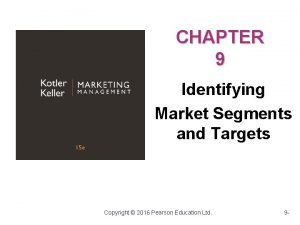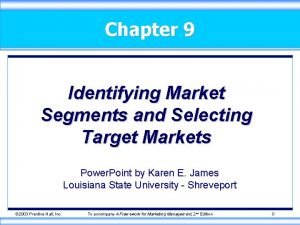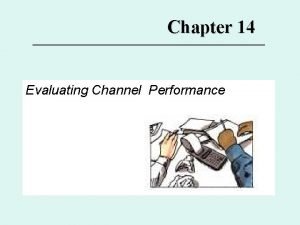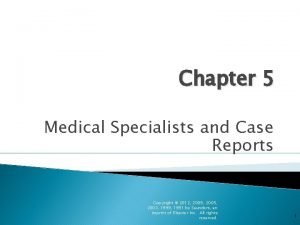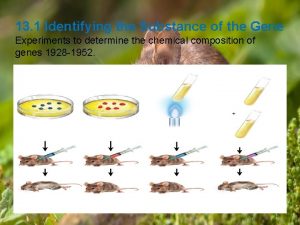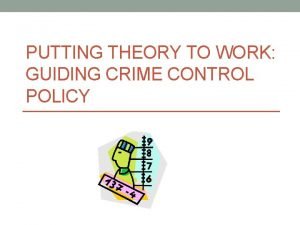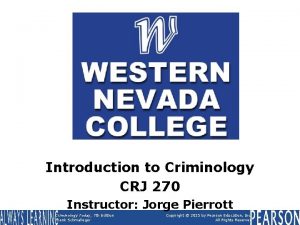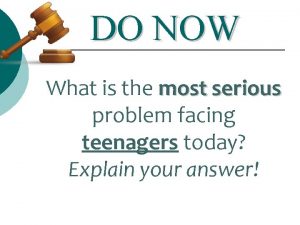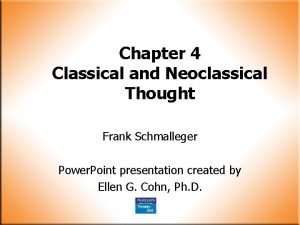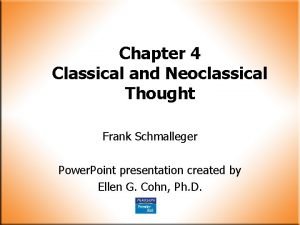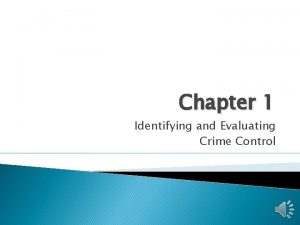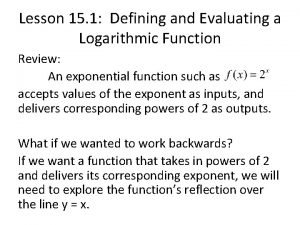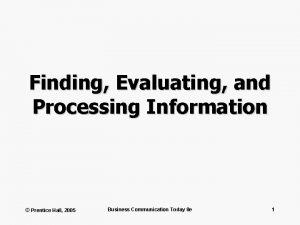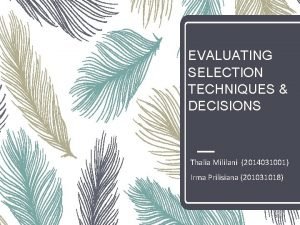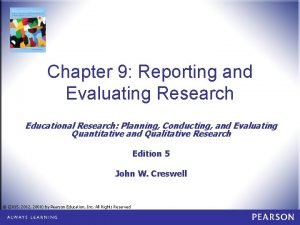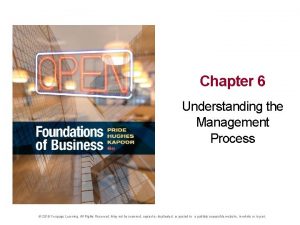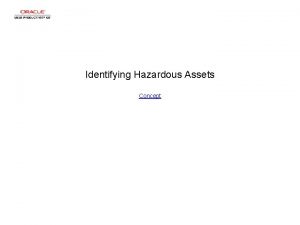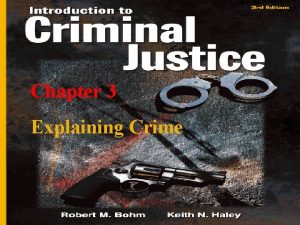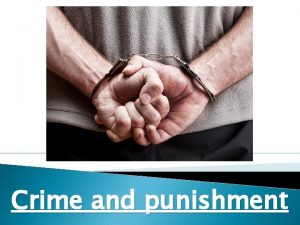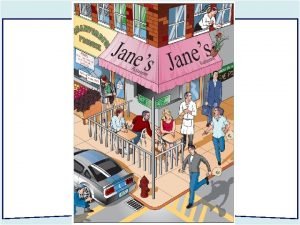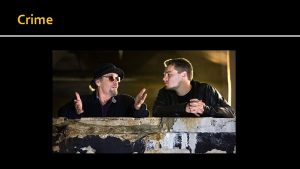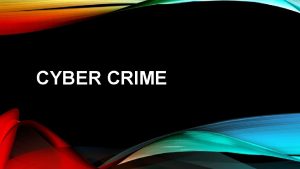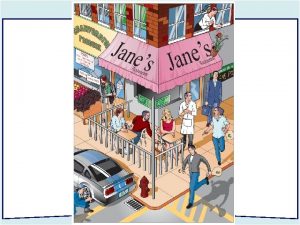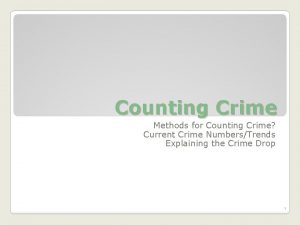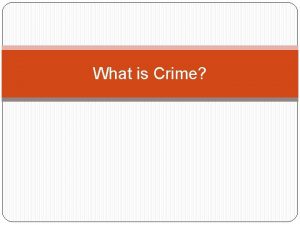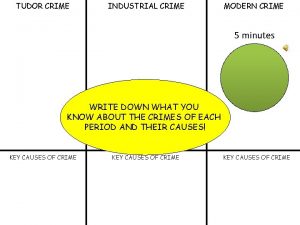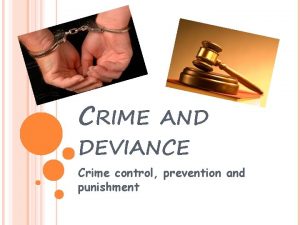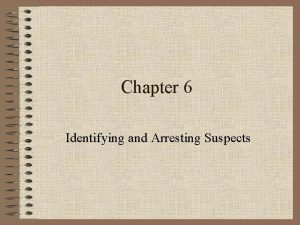Chapter 1 Identifying and Evaluating Crime Control Crime
























- Slides: 24

Chapter 1 Identifying and Evaluating Crime Control

Crime Control and Prevention Some people like the term “crime prevention” in lieu of “crime control” ◦ “Prevention” suggests a proactive approach ◦ “Control” suggests a reactive approach There is much overlap between crime prevention and control

Types of Crime is a concept that needs to be defined ◦ Penal codes spell out what is criminal ◦ Morals/beliefs may also help us decide what is right/wrong Why do we care about types of crime and defining it? ◦ Can’t discussion solutions to crime without reference to specific criminal acts

The Ever-Expanding Criminal Law The criminal law continues to expand in the face of new threats to public order and security An example is the Patriot Act passed in the wake of the September 11 th attacks

Incidence of Crime What is the incidence of crime? ◦ Depends on Where you look (e. g. , city or nation) Who you look at (e. g. , certain people or groups of people) Data sources

Costs of Crime and Criminals Individual perspective ◦ A single high-risk juvenile (one who commits 10. 6 crimes per year for six years) costs society between $1. 3 and $1. 5 million Aggregate perspective ◦ $1 trillion per year ($4, 118 each)

Is Fear of Crime Worse Than Crime Itself? � Fear of crime may be worse than crime itself � How do people become fearful? ◦ Shared stories ◦ Mass media ◦ Surroundings � The Victimization Paradox ◦ People fear becoming victims of crime much more than their likelihood of being victimized would suggest

Approaches, Not Just Policy The term “policy” tends to scare people away, so this course refers to “approaches” to the crime problem Approaches to the crime problem include ◦ Laws ◦ Official policies Written policies Unwritten policies ◦ Unofficial approaches

On the Importance of Definitions We can’t talk about the effectiveness of crime control in America without defining ◦ The problem ◦ The solution ◦ The desired outcome Abortion example ◦ The abortion debate cannot be won without attention to definitions, particularly the definition of when a life begins

Defining the Crime Problem � Our definition of the crime problem needs to strike a balance between overspecificity and vagueness � Overly-specific definition ◦ Strategy aimed at reducing second-degree burglary � Overly-vague definition ◦ Strategy aimed at reducing all types of crime simultaneously

Defining the Solution Again, a balance between vagueness and exacting detail needs to be reached Overly-specific definition Overly-vague definition ◦ Police department “decentralizes” by eliminating one sergeant’s position ◦ Community policing is the solution to crime Good definition (though not necessarily a good approach) ◦ Two officer instead of one officer patrols

Evaluating Success How do we know whether crime control is a success or failure? ◦ We conduct an evaluation Types of evaluation ◦ Process (not of interest in this course) ◦ Outcome (key for determining what works)

The Hard and Soft Sciences � Soft sciences ◦ Study of social phenomena in their natural settings ◦ Includes criminal justice, criminology, sociology, political science, economics, and others � Hard sciences ◦ Study of phenomena mostly in laboratory settings ◦ Includes chemistry, physics, biology, etc.

The Elusive Criminal Justice Experiment Classical experiments are ideal for evaluating crime policy Classical experiment consists of ◦ Treatment and control group (with random assignment to each group) ◦ Pretest and posttest (i. e. , measurement before and after) ◦ Controlled intervention (one the researcher controls)

You Can Prove Anything With Statistics Mark Twain said, “There are liars, damn liars, and statisticians” Statistics can be easily manipulated Reasons for easy manipulation include ◦ ◦ Many techniques for the same problem Different data sources Data mining Fudging

Displacement and Diffusion Proactive, directed, and creative policing may be effective, but it often pushes the problem (or benefits associated with it) into surrounding areas Displacement Diffusion ◦ Problem pushed into surrounding areas ◦ Benefits pushed into surrounding areas (free rider effect)

The Tentative Nature of Scientific Knowledge All scientific knowledge is tentative because ◦ ◦ ◦ It is not etched in stone It is not timeless New studies come along Alternative research designs are employed New data come available Alternative measures are used

The Measures Used Researchers often rely on different measures of the same phenomenon Examples ◦ UCR or NCVS to measure crime ◦ Funding/no funding or amount of funding to determine the impact of an intervention

When New Data Come Available New data are constantly coming available ◦ Crime statistics change every year ◦ Census data change every decade ◦ New sources of data pop up continually

Alternate Settings: The Generalization Problem Generalization ◦ The extent to which a researcher’s findings can be carried over to another location or series of locations Who cares? ◦ Not all programs/interventions are generalizable ◦ It may work “here” but not “there”

Resources Dictate Public Policy and Guide Research Crime control is dictated by what is being funded, which can have implications for what is researched Examples of funding that have either disappeared or won’t be around forever ◦ COPS ◦ Community policing ◦ Project Safe Neighborhoods

Academic Crusaders and Bandwagon Science Bandwagon science occurs when everyone chases the same funding and engages in the same type of research Academic crusaders are people who pursue their own agendas to the exclusion of practicing objective science

Effective Does Not Always Mean Best It is important to note that an effective approach to the crime problem is not necessarily the best one

Summary and Conclusion Chapter one summary and conclusion.
 Identifying and non identifying adjective clauses
Identifying and non identifying adjective clauses Identifying and non identifying adjective clauses
Identifying and non identifying adjective clauses Identifying and non identifying adjective clauses
Identifying and non identifying adjective clauses Chapter 7 deviance crime and social control
Chapter 7 deviance crime and social control Identifying market segments and targets chapter 9
Identifying market segments and targets chapter 9 Identifying market segments and targets
Identifying market segments and targets Identifying market segments and targets chapter 9
Identifying market segments and targets chapter 9 Criteria for evaluating performance of channel members
Criteria for evaluating performance of channel members Chapter 37 identifying career opportunities
Chapter 37 identifying career opportunities Identifying medical specialties chapter 7
Identifying medical specialties chapter 7 Chapter 13 lesson 1 identifying the substance of the gene
Chapter 13 lesson 1 identifying the substance of the gene Crime control policies
Crime control policies Crime control policies
Crime control policies Crime control policies
Crime control policies Neoclassical criminology essay
Neoclassical criminology essay Crime control policies
Crime control policies Crime control policies
Crime control policies Crime control policies
Crime control policies Writing and evaluating expressions
Writing and evaluating expressions 15.1 defining and evaluating a logarithmic function answers
15.1 defining and evaluating a logarithmic function answers Finding evaluating and processing information
Finding evaluating and processing information Thalia mililani
Thalia mililani Evaluating company resources and competitive capabilities
Evaluating company resources and competitive capabilities Reporting and evaluating research
Reporting and evaluating research The process of evaluating and regulating ongoing activities
The process of evaluating and regulating ongoing activities




